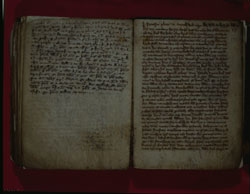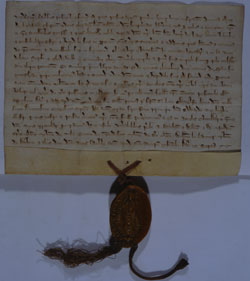 |
 |
 |
 |
 |
 |
 |
|
Kirkstall Abbey: sources (2/3) A number of Kirkstall’s charters have survived as apparent original single-sheet documents and include the Watson Collection, now in the Bodleian;(4) charters relating to the abbey’s holdings in Horsforth and Bramhope, now in the British Library;(5) the Allerton Charters, now at Leeds.(6) The most important collection, however, is The Coucher Book of Kirkstall, a compilation of the abbey’s holdings that was begun c. 1210 as a book of muniments by which the house held its possessions. Whereas the charters were initially arranged by vill, with spaces left for future acquisitions to be entered, this organisation was later ignored - the spaces were filled with miscellaneous documents such as a recipe for falling sickness and a papal bull, and later charters were omitted. This suggests that the Coucher Book was replaced by a second and more important chartulary, and from thereon used as a ‘scribble pad’ to record items that the monks wished to have at hand.(7) The Coucher Book is not a complete record of all the grants Kirkstall acquired; the later charters were not included but even many of the earlier deeds were omitted if their content was ratified by another deed. For example, Hugh de Lacy’s foundation charter (no. LXVII) confirms grants made by three of his vassals, two of which do not appear in the Coucher Book. A surviving rent roll of 1459 was edited by its owner, John Stansfeld, in 1891,(8) who suggests that it may have been one of a series, and that others were probably destroyed by tailors who chopped up the manuscripts to use as patterns. The 1459 rent roll provides a glimpse of abbey life in this year, showing the lands that Kirkstall held at this time, their value, and the names of those who held lands of them and were thus linked to the house.
Two fourteenth-century chronicles have been attributed to Kirkstall: the ‘Long Chronicle’ and the ‘Short Chronicle.’ Both are preserved in the Bodleian Library, Oxford, and were published by the Thoresby Society in 1952.(9) Whilst neither of the chronicles shed any light on the history of Kirkstall, and indeed it is not certain that they were actually written at the house, they do reveal something about historical writing at the abbey in the fourteenth century. The ‘Long Chronicle’ sketches a history from the time of King Vortigern (c. 370-459) until 1360 and deals with events unrelated to Kirkstall; it has been copied in the same hand as the Foundation of Kirkstall and on this basis ascribed to the abbey. The ‘Short Chronicle’, which was compiled at the turn of the fourteenth century, includes some important details relating to political affairs at the end of Richard II’s reign (1377-99). |

